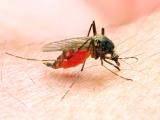Nov 20, 2012
Fungal meningitis cases hit 490
Over the past few days 10 more infections and one additional death have been reported in a fungal meningitis outbreak linked to tainted injectable steroids, according to an update yesterday from the US Centers for Disease Control and Prevention (CDC). The update raises the total case count to 490 and the death toll to 34. The methylprednisolone acetate doses from New England Compounding Center (NECC) implicated in the outbreak were also used to treat joint problems, and the CDC said it received one more report of a related peripheral joint infection, pushing that total to 12. Meanwhile, a Senate committee that is investigating the outbreak sent letters to pharmacy boards in all 50 states asking how they oversee compounding pharmacies and what actions they've taken in light of the outbreak, according to a statement yesterday from the Senate Health, Education, Labor, and Pensions (HELP) Committee. The committee held a hearing on Nov 15 to learn more about how the outbreak occurred and why regulators failed to prevent the tainted steroids from reaching patients.
Nov 19 CDC fungal meningitis outbreak update
Nov 19 Senate HELP committee statement
Nov 15 CIDRAP News story "Senate committee raises more meningitis outbreak questions"
Walkerton E coli outbreak caused no increase in cardiovascular events
The big Escherichia coli O157:H7 outbreak in Walkerton, Ont., in 2000 did not increase residents' subsequent risk of cardiovascular events, according to a report yesterday in the Canadian Medical Association Journal (CMAJ). The authors write that Shiga toxin released by the pathogen damages the kidneys, leading to hypertension, and may lead to chronic inflammation of the circulatory system, which may promote atherosclerosis. The researchers used data from the Walkerton Health Study and Ontario's healthcare databases to compare cardiovascular events in four groups of adults aged 40 to 89: 153 Walkerton residents who had severe gastroenteritis, 414 Walkerton residents who had mild gastroenteritis, 331 Walkerton residents with no gastroenteritis, and 11,263 people from surrounding communities unaffected by the outbreak. The participants were followed from 2002 through March 2010. Overall, 1,174 people died or had a major cardiovascular event. The analysis showed no increase in cardiovascular risk for those who had severe gastroenteritis (hazard ratio, 0.74; 95% confidence interval [CI], 0.38-1.43), and there was a slight decrease in risk for those with mild gastroenteritis (hazard ratio, 0.64; 95% CI, 0.42-0.98). The authors suggest that because of their participation in the Walkerton Health Study, residents may have received extra screening and treatment for hypertension and kidney disease. They found that the incidence of prescriptions for antihypertensive drugs increased more sharply among the Walkerton residents than in those of surrounding towns during the study period.
Nov 19 CMAJ report
Study finds gaps in rules on reptiles, amphibians in childcare centers
State regulations for preventing Salmonella transmission from reptiles and amphibians vary for childcare centers, as some rules banning dangerous animals don't appear to emphasize the known risks posed reptiles, researchers reported yesterday in a letter in Emerging Infectious Diseases. Investigators from Columbia University and EcoHealth Alliance, both based in New York, reviewed state regulations aimed at curbing Salmonella infections from reptiles and amphibians in childcare centers. They found that as of December 2011 only 50% of states had rules requiring staff and children to wash their hands after touching any animals. Twelve states banned reptiles from the centers, and 3 of the 12 also barred amphibians. Some states had rules barring dangerous animals from childcare centers, but only a few specifically mentioned reptiles. Colorado appeared to have the most explicit rules, which ban reptiles, amphibians, and potentially dangerous animals and also require staff and children to wash their hands after touching animals. The researchers said their review might underestimate regulations that are in place, because cities and counties might have them. However, they said their findings suggest that stronger regulations could boost public health efforts to reduce Salmonella infections in young children.
Nov 19 Emerg Infect Dis letter
Researchers detect BSE evidence in cattle saliva
Diagnosing bovine spongiform encephalopathy (BSE, or mad cow disease) typically requires brain or spinal cord samples, but a letter yesterday in Emerging Infectious Disease describes detection of BSE evidence in the saliva of cattle. Using Western blot and immunohistochemical tests, Japanese scientists detected the accumulation of BSE-causing misshapen prion proteins, called PrPSc, in brains collected at necropsy from three experimentally infected cows but also in saliva in all three cows at necropsy and in two of the cows at the early stages of clinical disease. After the saliva samples underwent three rounds of amplification, the team was able to detect PrPSc in the third cow 2 months before the onset of signs. They conclude, "Our findings suggest that PrPSc is likely to be detected in the saliva of BSE-affected cattle during the clinical stage of disease, after accumulation of PrPSc in the brain." They also say the presence of PrPSc in saliva may help explain the spread of two related diseases: scrapie in sheep and chronic wasting disease in deer.
Nov 19 Emerg Infect Dis letter
H5N1 strikes Bangladesh poultry farm
Livestock officials in Bangladesh yesterday announced an H5N1 avian influenza outbreak at a commercial poultry farm in Dhaka division, according to their report to the World Organization for Animal Health (OIE). The outbreak, which began on Oct 23, killed 156 of 4,191 susceptible birds, and the remaining ones were culled to curb the spread of the virus. Officials haven't yet determined how the flocks were infected. The country's last H5N1 outbreak occurred in April, when the virus struck nine poultry farms in Dhaka, Khulna, and Rajshahi divisions.
Nov 19 OIE report
NIH awards $19 million to start Georgia malaria center
The National Institutes of Health has awarded a 5-year contract worth up to $19.4 million to establish the Malaria Host-Pathogen Interaction Center (MaHPIC) in Georgia. Researchers from Emory University will head the center, with partners at the University of Georgia (UGA), the Georgia Institute of Technology (Georgia Tech), and the US Centers for Disease Control and Prevention (CDC), according to an Emory press release yesterday. The MaHPIC team will use a multidisciplinary systems-biology approach to study and catalog in detail how malaria parasites interact with their human and animal hosts in order to develop better diagnostics and treatment options. The principal investigator is Mary Galinski, PhD, professor of medicine, infectious diseases, and global health at the Emory University School of Medicine. MaHPIC plans to share the project's data and new analytical tools with the global scientific community via the Internet.
Nov 19 Emory University news release


















